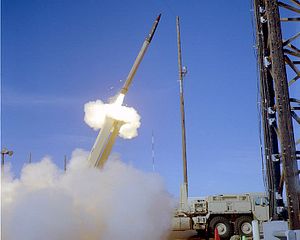On Tuesday, the United States Missile Defense Agency announced that the Terminal High Altitude Area Defense (THAAD) system had successfully passed its first-ever interception test of an intermediate-range ballistic missile (IRBM) target.
According to a statement released by the Agency, the test was conducted in Texas and was the 18th flight test of the THAAD system and 14th overall intercept test of the system since 2005. In that time, THAAD has seen 14 successful interceptions. Before Tuesday’s test, all targets that had been tested were of the short- and medium-range variety.
The United States defines IRBM-class projectiles as anything with a range between 3,000 kilometers to 5,500 kilometers. North Korea’s Hwasong-12 missile, first successfully flight tested in May 2017, is an example of an IRBM.
The U.S. Missile Defense Agency clarified the parameters of the test on Tuesday:
A ballistic missile target was air-launched by a U.S. Air Force C-17 over the Pacific Ocean north of Hawaii. A THAAD weapon system located at PSCA in Kodiak, Alaska, detected, tracked, and intercepted the target. Preliminary indications are that planned flight test objectives were achieved and the threat-representative, intermediate-range ballistic missile (IRBM) target was successfully intercepted by the THAAD weapon system.
According to the Agency, personnel involved in the test were not notified of the target’s launch time to partially simulate combat conditions. Soldiers from the U.S. Army’s 11th Air Defense Artillery Brigade reportedly “conducted launcher, fire control, and radar operations using the same procedures they would use in an actual combat scenario,” according to the Agency.
This latest test of the THAAD system follows a failed test of the SM-3 Block IIA interceptor against a medium-range ballistic missile (MRBM) target in June and a successful test of the Ground-Based Midcourse Defense (GMD) system against an intercontinental ballistic missile (ICBM) in May.
Though these tests have roughly coincided with a period of heavy North Korean ballistic missile testing, including last week’s North Korean launch of an ICBM for the first time, the Agency had been scheduled to carry out these tests in the 2017 fiscal year for some time.
The United States deployed two THAAD launchers in South Korea in early May and four more are pending deployment following an environmental assessment by the current South Korean government.
The current THAAD site in South Korea, in Seongju county, 300 kilometers southeast of Seoul, would allow the system to defend the southern part of the Korean peninsula. Lt. Gen. Thomas S. Vandal, commander of the United States Eighth Army in South Korea, said that the system would provide coverage to more than 10 million South Koreans.
THAAD missiles use hit-to-kill interceptors to destroy incoming projectiles at a high altitude in the terminal stages of their flight. This means that the physical positioning of THAAD batteries and the orientation of the system’s accompanying AN/TPY-2 X-band radar constrains the coverage range. In the South Korean case, North Korea may be able to defeat THAAD by firing submarine-launched ballistic missiles from an unfavorable angle.
THAAD continues to have no ability to intercept ICBMs. Its proven IRBM intercept also does not mean that the South Korea-based THAAD interceptor could destroy North Korean IRBMs in midcourse flight over the Pacific.

































